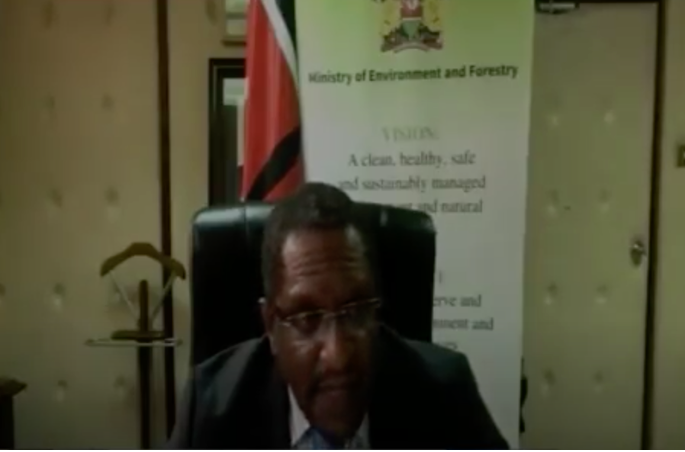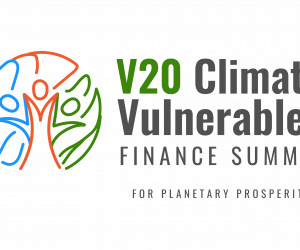Keriako Tobiko – UNGA Event 2020

Source: Climate Vulnerable Forum
H.E. Keriako Tobiko, Cabinet Secretary for the Ministry of Environment and Forestry of Kenya
Climate Vulnerable Forum Leaders Event
October 7, 2020
Honorable chair,
Excellencies,
Distinguished participants.
Kenya is pleased to have been invited to participate in this crucially important event.
As clearly demonstrated in the recent UN Environment Adaptation Gap report, the need for collective action and high ambition are not a matter of choice, but an absolute necessity in order to avert unbearable loss and damage; especially for the already struggling, developing and climate vulnerable countries.
Climate related disasters, including droughts, floods, cyclones, heat waves,… are becoming more frequent and intense. And their impacts are adversely affecting all, but more so vulnerable communities and their livelihoods.
In recognition of the various threats posed by climate change, Kenya has taken and continues to take bold measures to secure the country’s development against the risks and impacts of climate change.
Kenya is among the first countries in Africa to pass the climate change act as the National Climate Change action plan, the National adaptation plan, and the green economy strategy implementation plan.
Kenya’s National Climate Change action plan for 2018-2022, which is the current plan, prioritizes adaptation and mitigation intervention in areas such as disaster risk management, food nutrition security, water and economy, forestry, wildlife and tourism, health and sanitation, human settlement, manufacturing, energy, and transport.
This plan that runs for five years is estimated to cost roughly 18 billion US dollars over the period of five years.
Despite contributing less than 1% of global emissions, Kenya has stayed on a low carbon development pathway.
In the energy sector, Kenya is among the top eight global leaders in geothermal power development; home to the first and the largest geothermal and wind power project in Africa; and ready to scale up our efforts in renewable energy with adequate support.
Currently, 92% of the electricity dispersed and used by Kenyans is from renewable energy sources. Kenya plans to increase the use of renewable energy even further.
However, like most other developing countries, biomass is the main source of energy for cooking for households in Kenya, and a major energy source for the whole country.
Kenya plans to achieve 100% access to clean energy cooking – clean cooking – by 2030. Kenya’s transport sector is the largest consumer of liquid fossil fuels. To raise ambition in the transport sector, we have developed sustainable urban mobility plans that are now in pilot phase and planned for the introduction of the bus rapid transit (BRT) systems that are integrated with non-motorized transport for the city of Nairobi; and assessing potential for transition to E-mobility.
We are also focusing on transfer of passengers and freight from road to rail and have the potential for extending and electrifying in our Standard Gauge Railway.
Kenya’s forestry sector has the highest technical mitigation potential in our NDC.
The Constitution obligates us to maintain at least 10% forest cover. Presently, we are at 7.2%. Kenya has established an ambitious program, led by His Excellency the President, aiming at growing 1.8 billion trees by 2022.
In addition, under the Bonn challenge and the AFR100, Kenya has committed to restore 5.1 million hectares of degraded ecosystems by 2030. These interventions will include public private partnership to promote commercial forestry and urban green spaces.
In 2015 Kenya took an ambitious target to reduce emissions by 30% by 2030, using the business-as-usual scenario.
In the last few months, we have been doing a self-assessment evaluation of our performance since we submitted our INDCs in 2015. Despite the disruption of COVID-19 pandemic, I wish to confirm that Kenya is on the road to submitting its updated revised NDC by the due date of December 2020.
Kenya has also started a process of developing a long-term greenhouse gas strategy for 2050, as our contribution towards the global target of carbon neutrality by 2050. The long-term strategy for 2050 will also be submitted to the UNFCCC in the course of next year. In building resilience towards climate change and end pandemics, such as COVID-19, we must also remember that our solutions lie in nature.
Nature-based solutions with biodiversity and environmental safeguards can help protect, sustainably manage and restore natural or modified ecosystems. Effective mitigation and adaptation action will also require international cooperation in research, technological transfers and capacity building. Research is particularly needed for evidence-based interventions, and to carve the 2050 long term mitigation and adaptation pathways for priority sectors.
I thank you.


